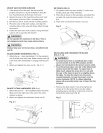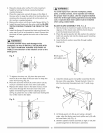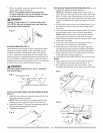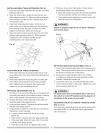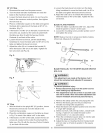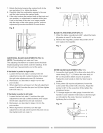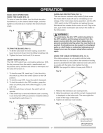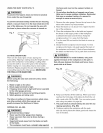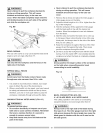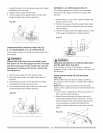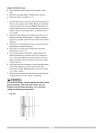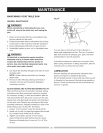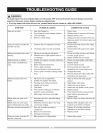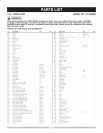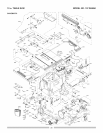
USINGTHE DUST CHUTE (FIG. Y)
IA WARNINGI
To prevent fire hazard, clean and remove sawdust
from under the saw frequently.
To prevent sawdust buildup inside the saw housing,
attach a vacuum hose (1) to the dust chute (2) at the
rear of the table saw. Do not operate the saw with
the hose in place unless the vacuum is turned on.
Fig. Y
CUTTING OPERATIONS
There are two basic types of cuts: ripping and
crosscutting. Ripping is cutting along the length and the
grain of the workpiece. Crosscutting is cutting either
across the width or across the grain of the workpiece.
Neither ripping nor crosscutting may be done safely
freehand. Ripping requires the use of the rip fence, and
crosscutting requires the miter gauge. NEVER USE
THE TWO AT THE SAME TIME.
the fence and must not be warped, twisted, or
bowed.
Do not allow familiarity or frequent use of your
table saw to cause careless mistakes. Remember
that even a careless fraction of a second is
enough to cause a severe injury.
1. Remove the miter gauge. Secure the rip fence to the
table at the desired rip measurement.
2. Raise the blade so it is about 1/8 in. higher than the
top of the workpiece.
3. Place the workpiece fiat on the table and against
the fence so the larger portion of the workpiece
is between the blade and the fence. Keep the
workpiece about 1 in. away from the blade.
4. Turn the saw ON and wait for the blade to come up
to speed.
5. Slowly feed the workpiece into the blade. To feed
workpiece into blade, only push against the back of
the workpiece on the part (1) that will pass between
the blade and the fence. Use a push stick at all times.
l a, WARNINGI
AVOID KICKBACK To avoid kickback, only push
against the back of the workpiece on the part (1)
that will pass between the blade and fence. Use a
push stick at all times.
Fig. AA
[A WARNI"GI
Before using the saw each and every time, check
the following:
1. Blade is tight on the arbor.
2. Bevel angle lock knob is tight.
3. if ripping, fence knob is tight and fence is parallel
to the miter gauge grooves.
4. Blade guard is in place and working properly.
5. Safety glasses are being worn.
The failure to adhere to these common safety rules,
and other printed within this manual, can
greatly increase the likelihood of injury.
RIPPING (FIG. AA, BB)
[A WARNINGI
To prevent serious injury:
• Never use the miter gauge when ripping.
= Never use more than one rip fence during a
single cut.
= Keep both hands away from the blade and path
of the blade.
• The workpiece must have a straight edge against
6. Keep your thumbs off the table top. When your hand
reaches the front edge of the table (2), finish the cut
with a push stick (3) (Fig. BB). You can make a push
stick using the pattern on page 28.
7. The push stick (3) should always be used for any
ripping operations. (Fig. BB)
8. Continue pushing the workpiece with the push
stick (3) until it passes the blade guard and clears the
rear of the table.
18




